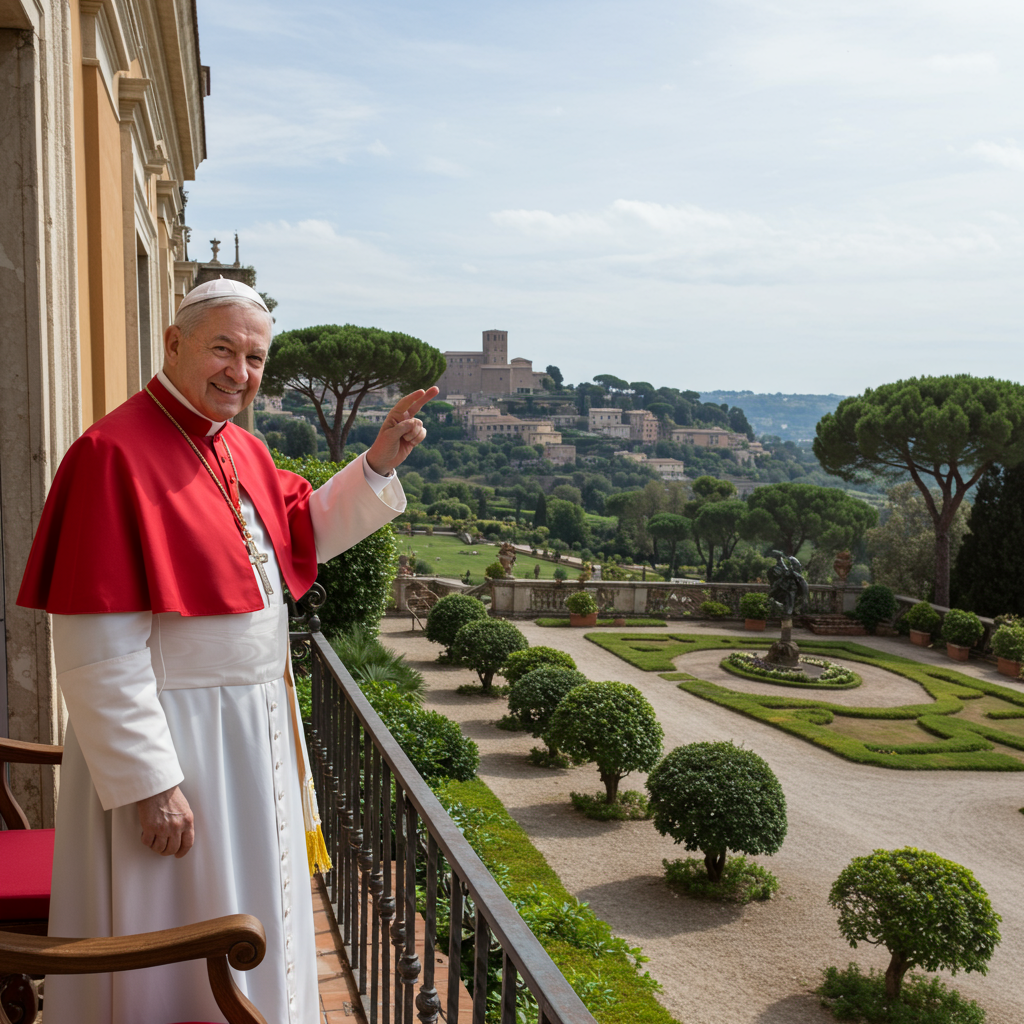Pope Leo XIV is set to revive a cherished papal tradition, taking his summer break in the serene hilltop town of castel Gandolfo, located just outside Rome. This move marks a significant return to customs followed by centuries of pontiffs, offering a stark contrast to his immediate predecessor’s practice. The announcement has sparked palpable excitement among locals, eager to see the “second Vatican” nickname restored to their picturesque community overlooking Lake Albano. This summer stay is more than just a vacation; it symbolizes a connection to history, community, and perhaps even offers a chance for the pontiff to unwind on the estate’s grounds.
Centuries of Papal Summertime Tradition
For over 400 years, dating back to Pope Urban VIII in 1623, Castel Gandolfo served as the traditional summer escape for popes seeking respite from Rome’s scorching heat. The pontifical villas, sprawling across 135 acres—an area larger than Vatican City itself—provided a cooler climate and space for both rest and work. Popes like John Paul II and Benedict XVI regularly spent several months a year at the complex, which grew over time to include multiple residences, formal gardens, and even a working farm. Benedict XVI held a particular fondness for the town, even retiring there briefly after his resignation in 2013.
A Recent Break in Tradition
The long-standing tradition saw a notable pause during the pontificate of Pope Francis. Choosing instead to remain within the Vatican throughout the summer months, Francis broke with the custom. While he visited Castel Gandolfo three times early in his papacy, including to see Pope Benedict XVI, he never stayed overnight. To mitigate the economic impact on the town from the pope’s absence, Francis opened the papal gardens to the public in 2014 and converted the traditional papal apartment in the Apostolic Palace into a museum in 2016. This departure left many Castel Gandolfo residents feeling “orphaned,” as one local expressed.
Pope Leo XIV’s Return and Residence Details
The news last month that Pope Leo XIV would spend two weeks in July, and a few days in August, at Castel Gandolfo was met with immense relief and enthusiasm. His stay is scheduled from July 6 to July 20, with a return visit planned around the Feast of the Assumption on August 15, extending to August 17, 2025.
Crucially, Pope Leo will not reside in the historic Apostolic Palace, which now functions as a museum. Instead, he will stay at Villa Barberini, another residence within the expansive pontifical estate. This villa previously housed the Vatican’s Secretary of State and the Prefect of the Papal Household. Recent renovations were undertaken to prepare Villa Barberini and upgrade facilities for the Swiss Guard and Gendarmerie accompanying him. While the estate boasts stunning views of Lake Albano, reports suggest the Pope’s private bedroom in Villa Barberini faces the interior for security reasons, meaning he may not have a direct lake view from his room.
Planned Activities and Public Appearances
During his stay, Pope Leo XIV will engage with the local community and revive public appearances from Castel Gandolfo. The Prefecture of the Papal Household has announced several scheduled events. On Sunday, July 13, he will celebrate Mass at the pontifical parish of St. Thomas of Villanova in Castel Gandolfo, a significant figure for Pope Leo given his own Augustinian order and connection to Villanova University. Following the Mass, he will deliver the noontime Angelus address from the Piazza della Libertà, reviving a familiar sight for locals and visitors. He plans to repeat the Angelus from the same location on August 15 (the Assumption/Ferragosto holiday) and August 17. Before returning to the Vatican on July 20, he will celebrate Mass at the cathedral church in nearby Albano. These appearances are expected to draw crowds and provide a significant boost to the town’s atmosphere and economy.
Impact and Symbolism of the Revival
The return of a reigning pontiff is seen as restoring Castel Gandolfo to its historical prominence. Mayor Alberto De Angelis highlighted the town’s deep connection to the Vatican, stating, “You can’t imagine St. Peter’s without the pope, and you can’t imagine Castel Gandolfo without the pope.” Residents like Mario Pastrana praised the town as an ideal spot for relaxation, calling it “so beautiful, it’s so reserved, it’s next to a lake,” and significantly calmer than Rome.
Pope Leo XIV’s decision is viewed by many as part of a broader pattern of embracing traditional aspects of the papacy. This aligns with previous actions like using specific papal attire (mozzetta and stole), planning to reside in the Vatican’s Apostolic Palace, and restoring the traditional Corpus Christi procession route. These choices are seen as responses to calls for unity made before his election and are thought to reinforce the historical bond between the Pope and the people of Rome and its surrounding areas like Castel Gandolfo, emphasizing his role as the Bishop of Rome.
Connecting with Projects and Pursuits
The pontifical estate is also home to Borgo Laudato Si’, an ecological project initiated under Pope Francis. Staying on the grounds allows Pope Leo to observe its progress firsthand and lend encouragement to its work promoting integral ecology. Beyond official duties, the spacious grounds offer opportunities for personal leisure. The Villa Barberini estate features a tennis court and an indoor swimming pool commissioned by Pope John Paul II. While the Vatican itself has limited sports facilities (a point highlighted by Giampaolo Mattei of Athletica Vaticana, noting the lack of tennis courts within Vatican City), Castel Gandolfo offers these amenities. Given Pope Leo XIV’s known interest in tennis and general sportiness, these facilities could provide him with a private space to unwind, acknowledging that even a Pope needs personal time to “get away” and “relax.”
Practical Information for Visitors
With Pope Leo XIV in residence, visitors planning to visit Castel Gandolfo or the Vatican should be aware of a few key points. The papal apartments in the Apostolic Palace museum will remain open to the public as usual during his stay. However, public and private audiences at the Vatican are suspended for the majority of July, scheduled to resume on July 30. Those hoping to see the Pope in person should plan to attend the scheduled Angelus addresses in Piazza della Libertà on the specified July and August Sundays or seek out the announced Masses.
Frequently Asked Questions
What is the significance of Pope Leo XIV returning to Castel Gandolfo?
Pope Leo XIV’s decision revives a nearly 400-year-old tradition of popes spending their summer outside Rome. This move is seen as a return to historical papal customs, differing from his predecessor Pope Francis. It holds symbolic importance for tradition, community ties with Castel Gandolfo, and aligns with Pope Leo’s other traditional choices.
Where exactly will Pope Leo XIV be staying in Castel Gandolfo?
He will reside at Villa Barberini, which is part of the larger pontifical estate in Castel Gandolfo. This is distinct from the Apostolic Palace on the grounds, where previous popes stayed and which was converted into a museum under Pope Francis. Villa Barberini underwent recent renovations for the Pope’s arrival.
Will the Pope be performing public duties or services while at Castel Gandolfo?
Yes, Pope Leo XIV has several public appearances scheduled. He plans to celebrate Mass at local churches, including St. Thomas of Villanova in Castel Gandolfo and the cathedral in Albano. He will also deliver the traditional Sunday Angelus blessing to the faithful gathered in Piazza della Libertà in Castel Gandolfo on specific Sundays in July and August.
Pope Leo XIV’s summer at Castel Gandolfo represents a conscious step back towards long-held papal traditions. Beyond providing personal rest for the Pontiff, it revitalizes the connection between the papacy and this historic town, offering a glimpse into a different rhythm of papal life compared to the bustling Vatican. His presence is a source of hope and renewed identity for Castel Gandolfo, echoing its historical role as the “second Vatican.” This period will allow him to continue his duties while embracing a heritage cherished by many.
Word Count Check: 1135


